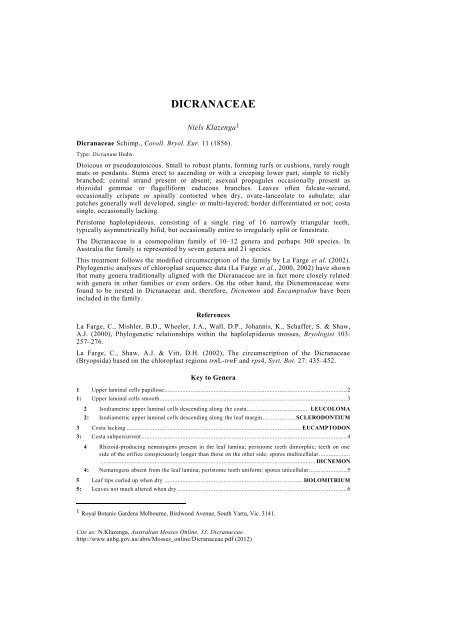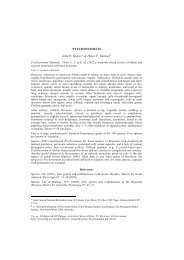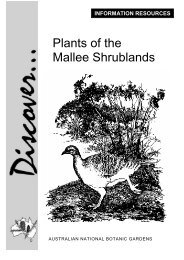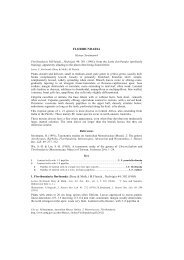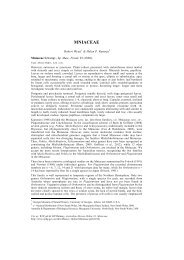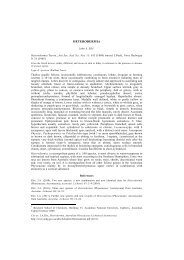Dicranaceae - Australian National Botanic Gardens
Dicranaceae - Australian National Botanic Gardens
Dicranaceae - Australian National Botanic Gardens
You also want an ePaper? Increase the reach of your titles
YUMPU automatically turns print PDFs into web optimized ePapers that Google loves.
DICRANACEAE<br />
Niels Klazenga 1<br />
<strong>Dicranaceae</strong> Schimp., Coroll. Bryol. Eur. 11 (1856).<br />
Type: Dicranum Hedw.<br />
Dioicous or pseudoautoicous. Small to robust plants, forming turfs or cushions, rarely rough<br />
mats or pendants. Stems erect to ascending or with a creeping lower part, simple to richly<br />
branched; central strand present or absent; asexual propagules occasionally present as<br />
rhizoidal gemmae or flagelliform caducous branches. Leaves often falcate-secund,<br />
occasionally crispate or spirally contorted when dry, ovate-lanceolate to subulate; alar<br />
patches generally well developed, single- or multi-layered; border differentiated or not; costa<br />
single, occasionally lacking.<br />
Peristome haplolepideous, consisting of a single ring of 16 narrowly triangular teeth,<br />
typically asymmetrically bifid, but occasionally entire to irregularly split or fenestrate.<br />
The <strong>Dicranaceae</strong> is a cosmopolitan family of 10–12 genera and perhaps 300 species. In<br />
Australia the family is represented by seven genera and 21 species.<br />
This treatment follows the modified circumscription of the family by La Farge et al. (2002).<br />
Phylogenetic analyses of chloroplast sequence data (La Farge et al., 2000, 2002) have shown<br />
that many genera traditionally aligned with the <strong>Dicranaceae</strong> are in fact more closely related<br />
with genera in other families or even orders. On the other hand, the Dicnemonaceae were<br />
found to be nested in <strong>Dicranaceae</strong> and, therefore, Dicnemon and Eucamptodon have been<br />
included in the family.<br />
References<br />
La Farge, C., Mishler, B.D., Wheeler, J.A., Wall, D.P., Johannis, K., Schaffer, S. & Shaw,<br />
A.J. (2000), Phylogenetic relationships within the haplolepideous mosses, Bryologist 103:<br />
257–276.<br />
La Farge, C., Shaw, A.J. & Vitt, D.H. (2002), The circumscription of the <strong>Dicranaceae</strong><br />
(Bryopsida) based on the chloroplast regions trnL-trnF and rps4, Syst. Bot. 27: 435–452.<br />
Key to Genera<br />
1 Upper laminal cells papillose ............................................................................................................... 2<br />
1: Upper laminal cells smooth.................................................................................................................. 3<br />
2 Isodiametric upper laminal cells descending along the costa ...................................... LEUCOLOMA<br />
2: Isodiametric upper laminal cells descending along the leaf margin .................... SCLERODONTIUM<br />
3 Costa lacking .......................................................................................................... EUCAMPTODON<br />
3: Costa subpercurrent ............................................................................................................................. 4<br />
4 Rhizoid-producing nematogens present in the leaf lamina; peristome teeth dimorphic; teeth on one<br />
side of the orifice conspicuously longer than those on the other side; spores multicellular...................<br />
................................................................................................................................... DICNEMON<br />
4: Nematogens absent from the leaf lamina; peristome teeth uniform; spores unicellular ....................... 5<br />
5 Leaf tips curled up when dry .................................................................................... HOLOMITRIUM<br />
5: Leaves not much altered when dry ....................................................................................................... 6<br />
1 Royal <strong>Botanic</strong> <strong>Gardens</strong> Melbourne, Birdwood Avenue, South Yarra, Vic. 3141.<br />
Cite as: N.Klazenga, <strong>Australian</strong> Mosses Online. 33. <strong>Dicranaceae</strong>.<br />
http://www.anbg.gov.au/abrs/Mosses_online/<strong>Dicranaceae</strong>.pdf (2012)
6 Leaf border not differentiated; alar patches at least partly 2-layered .............................. DICRANUM<br />
6: Leaves with a border of linear hyaline cells with very narrow lumina ............................................... 7<br />
7 Capsules cylindrical, straight to curved; peristome teeth asymmetrically bifid, vertically to obliquely<br />
striate in the basal part, mostly with cross connections between striae on the outer side ...........................<br />
................................................................................................................................ DICRANOLOMA<br />
7: Capsules ovoid, straight; peristome teeth very fragile, entire or irregularly fenestrate or split, mostly<br />
with pieces broken off, papillose outside ................................................................... HOLOMITRIUM<br />
Doubtful Record<br />
Mesotus celatus Mitt., in J.D.Hooker, Handb. New Zealand Fl. 2: 462 (1867)<br />
Mesotus acutus Mitt., Trans. & Proc. Roy. Soc. Victoria 19: 52 (1882). T: “ex Australia, inter<br />
Sphaerophoron”, Hb. Borrer; holo: NY, fide B.H.Allen, J. Bryol. 14: 445 (1987).<br />
The label on the type of M. acutus indicates that the specimen originated in Australia, but no<br />
further locality information was provided. Mesotus celatus is otherwise not known from<br />
Australia, and is considered to be a New Zealand endemic.<br />
2


